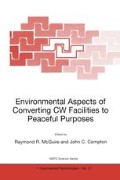Abstract
Thevesicant 2-chlorovinyldichoroarsine (lewisite I) was produced in large quantities between World War I and II, and is one of the chemical warfare agents that needs to be destroyed under the Chemical Weapons Convention (CWC) [1]. The Netherlands Government has offered the Russian Federation assistance in the realisation of elements of a facility for the destruction of lewisite I stored in the area of Kambarka. One of those elements is a soil remediation plant. In turn, TNO Prins Maurits Laboratory (TNO-PML) advises the Netherlands Government on technical details of several topics including methods for analysing environmental samples for lewisite residues. A short survey of available analytical methods described in the literature is presented and some own research is introduced. The methods are either based on gas chromatography (GC) or liquid chromatography (LC).
Access this chapter
Tax calculation will be finalised at checkout
Purchases are for personal use only
Preview
Unable to display preview. Download preview PDF.
References
Convention on the Prohibition of the Development, Production, Stockpiling and Use of Chemical Weapons and on their Destruction, Organisation for the Prohibition of Chemical Weapons, The Hague.
Canadian Handbook for the investigation of the allegations of the use of chemical and biological weapons (1985).
Cooper, D.B., Hall, T.A., and Utley, D. (1990) The identification of lewisite residues at the former chemical weapons storage site at Bowes Moor, NATO AC 225 (Panel VII/SICA) Notice N/176.
Rautio, M. (ed), (1994) Recommended operating procedures for sampling and analysis in the verification of chemical disarmament, The Ministry for Foreign Affairs of Finland, Helsinki.
Ali-Mattila, E., Siivinen, K., Kenttämaa, H. and Savolahti, P. (1983) Mass Spectrometric Methods in Stnictural Analysis of Some VesicantsInt. J. Mass Spectrom. Ion Phys.47, 371–374.
Fowler, W.K., Stewart, D.C., Weinberg, D.S. (1991) Gas chromatographic determination of the lewisite hydrolysate, 2-chlorovinylarsonous acid, after derivatization with 1,2-ethanediol, J.Chromatogr.558, 235–246.
Szostek, B. and Aldstadt, J.H. (1998) Determination of organoarsenicals in the environment by solid-phase microextraction-gas chromatography-mass spectrometryJ. Chromntogr. A807, 253–263.
Expert Group on Inspection Procedures (1996), Twelfth report PC-XIVB/WP.4, Annex 3, Technical Secretariat of the Organisation for the Prohibition of Chemical Weapons, The Hague.
Bossle, P.C. (1991) Determination of 2-chlorovinylarsonic acid in environmental waters by ion chromatography, US Army Edgewood Research Development and Engineering Center.
Kientz, C.E. (1992) Microcolunul liquid chromatography coupled with flame-based gas chromatographic detectors, Thesis, Free University Amsterdam.
Oudhoff, K. and Dijkstra, R.J. (1998) Development of analysis and identification methods for five arsenic compounds, Free University Amsterdam (Dutch language only).
Cheicante, R.L., Stuff, J.R. and Dupont Durst, H. (1995) Analysis of chemical weapons degradation products by capillary electrophoresis with UV detectionJ. Cap. Elec. 4157–163.
Author information
Authors and Affiliations
Editor information
Editors and Affiliations
Rights and permissions
Copyright information
© 2002 Springer Science+Business Media Dordrecht
About this paper
Cite this paper
Wils, E.R.J. (2002). Trace Analytical Methods for the Analysis of Lewisite Residues. In: McGuire, R.R., Compton, J.C. (eds) Environmental Aspects of Converting CW Facilities to Peaceful Purposes. NATO Science Series, vol 37. Springer, Dordrecht. https://doi.org/10.1007/978-94-010-0508-1_11
Download citation
DOI: https://doi.org/10.1007/978-94-010-0508-1_11
Publisher Name: Springer, Dordrecht
Print ISBN: 978-1-4020-0997-6
Online ISBN: 978-94-010-0508-1
eBook Packages: Springer Book Archive

